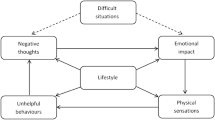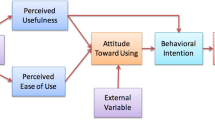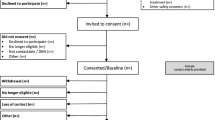Abstract
There is evidence for the effectiveness of computer-assisted therapies (CAT) in healthcare; however, implementing CAT can be challenging due to new technologies being perceived as ‘disruptive’. This study used normalisation process theory (NPT) to investigate how Breaking Free Online (BFO), a treatment programme for substance misuse, is embedded as normal practice within Crime Reduction Initiatives (CRI), a health and social care charity. Interviews were conducted with CRI staff regarding their perceptions of the normalisation of BFO. Thematic analyses were used and findings structured around NPT. Results suggest that staff understood the benefits of BFO, particularly for those with a dual diagnosis. However, there was some confusion surrounding job roles and difficulties with the availability of resources. Whilst normalisation of BFO is progressing within CRI, there are still some challenges. Clarification of the roles of staff and peer mentors is an area in which further work is being conducted.
Similar content being viewed by others
References
Carroll K, Ball S, Martino S, et al. Computer-assisted delivery of cognitive-behavioral therapy for addiction: A randomized trial of CBT4CBT. The American Journal of Psychiatry. 2008;165(7):881–888.
Elison S, Humphreys L, Ward J, et al. A Pilot Outcomes Evaluation for Computer Assisted Therapy for Substance Misuse- An Evaluation of Breaking Free Online. Journal of Substance Use. 2013;19(4):1–6.
Elison S, Ward J, Davies G, et al. An outcomes study of eTherapy for dual diagnosis using Breaking Free Online. Advances in Dual Diagnosis. 2014;7(2):52–62.
Elison S, Ward J, Davies G, et al. Implementation of computer-assisted therapy for substance misuse: a qualitative study of Breaking Free Online using Roger’s diffusion of innovation theory. Drugs and Alcohol Today. 2014;14(4):207–218.
Elison S, Davies G, Ward J. Sub-group analyses of a heterogeneous sample of service users accessing computer-assisted therapy (CAT) for substance dependence using Breaking Free Online. Journal of Medical Internet Research. 2015;2(2):e13.
Kay-Lambkin FJ, Baker AL, Lewin TJ, et al. Computer-based psychological treatment for comorbid depression and problematic alcohol and/or cannabis use: a randomized controlled trial of clinical efficacy. Addiction. 2009;104(3):378–388.
Kay-Lambkin F, Baker A, Lewin T, et al. Acceptability of a Clinician-Assisted Computerized Psychological Intervention for Comorbid Mental Health and Substance Use Problems: Treatment Adherence Data from a Randomized Controlled Trial. Journal of Medical Internet Research. 2011;13(1):254–264.
Carroll KM, Rounsaville BJ. Computer-assisted therapy in psychiatry: Be brave—it’s a new world. Current Psychiatry Reports. 2010;12(5):426–432.
Andrews G, Cuijpers P, Craske MG, et al. Computer therapy for the anxiety and depressive disorders is effective, acceptable and practical health care: a meta-analysis. PloS one. 2010;5(10):e13196.
Kaltenthaler E, Brazier J, De Nigris E, et al. Computerised cognitive behaviour therapy for depression and anxiety update: a systematic review and economic evaluation. Health Technology Assessment. 2006;10(33):1–186.
Edmondson AC, Bohmer RM, Pisano GP. Disrupted routines: Team learning and new technology implementation in hospitals. Administrative Science Quarterly. 2001;46(4):685–716.
Rogers E. Diffusion of innovations. New York: Simon and Schuster; 1995.
Rogers E. Diffusion of preventive innovations. Addictive Behaviors. 2002;27(6):989–993.
Rogers E. A Prospective and Retrospective Look at the Diffusion Model. Journal of Health Communication. 2004;9(sup1):13–19.
Barnett J, Vasileiou K, Djemil F, et al. Understanding innovators’ experiences of barriers and facilitators in implementation and diffusion of healthcare service innovations: a qualitative study. BMC Health Services Research. 2011;11(1):342.
Craig P, Dieppe P, Macintyre S, et al. Developing and evaluating complex interventions: the new Medical Research Council guidance. BMJ. 2008;337(sep29_1):a1655-a1655.
Simpson DD, Dansereau DF. Assessing organizational functioning as a step toward innovation. Science & Practice Perspectives. 2007;3(2):20–28.
May C, Finch T, Mair F, et al. Understanding the implementation of complex interventions in health care: the normalization process model. BMC Health Services Research. 2007;7(1):148.
Mair FS, May C, O’Donnell C, et al. Factors that promote or inhibit the implementation of e-health systems: an explanatory systematic review. Bulletin of the World Health Organization. 2012;90(5):357–364.
Lewin S, Glenton C, Oxman AD. Use of qualitative methods alongside randomised controlled trials of complex healthcare interventions: Methodological study. BMJ. 2009;339.
Oakley A, Strange V, Bonell C, et al. Health services research: process evaluation in randomised controlled trials of complex interventions. BMJ. 2006;332(7538):413.
NVivo 10. NVivo qualitative data analysis software; QSR Internation Pty, Limited. Version 10, 2012. 2012.
Braun V, Clarke V. Using thematic analysis in psychology. Qualitative Research in Psychology. 2006;3(2):77–101.
Amering M, Schmolke M. Recovery in mental health: reshaping scientific and clinical responsibilities. Vol 7: John Wiley & Sons; 2009.
Flores PJ. Addiction as an attachment disorder: Implications for group therapy. International Journal of Group Psychotherapy. 2001;51(1: Special issue):63–81.
Flores PJ. Group psychotherapy with addicted populations: An integration of twelve-step and psychodynamic theory. New York: Routledge; 2013.
Miller WR, Sorensen JL, Selzer JA, et al. Disseminating evidence-based practices in substance abuse treatment: A review with suggestions. Journal of Substance Abuse Treatment. 2006;31(1):25–39.
Cohen WM, Levinthal DA. Absorptive capacity: a new perspective on learning and innovation. Administrative Science Quarterly. 1990:128–152.
White WL. Recovery: Its history and renaissance as an organizing construct concerning alcohol and other drug problems. Alcohol Treatment Quarterly. 2005;23(1):3–15.
White WL. Peer-based Addiction Recovery Support- History, Theory, Practice, and Scientific Evaluation. Counselor. 2009;10(5):54–59.
Murray E, Treweek S, Pope C, et al. Normalisation process theory: a framework for developing, evaluating and implementing complex interventions. BMC Medicine. 2010;8(1):63.
Doughty C, Tse S. Can consumer-led mental health services be equally effective? An integrative review of CLMH services in high-income countries. Community Mental Health Journal. 2011;47(3):252–266.
Nilsen ES, Myrhaug HT, Johansen M, et al. Methods of consumer involvement in developing healthcare policy and research, clinical practice guidelines and patient information material. Cochrane Database of Systematic Reviews. 2006;3.
Best D, Laudet A. The potential of recovery capital. London: RSA; 2010.
Burns J, Marks D. Can Recovery Capital Predict Addiction Problem Severity? Alcohol Treatment Quarterly. 2013;31(3):303–320.
Peele S, Brodsky A. The Truth About Addiction and Recovery. New York: Simon and Schuster; 1991.
Dugdale S, Elison S, Davies G, et al. Using the Transtheoretical Model to explore the impact of peer mentoring on peer mentors’ own recovery from substance misuse. Journal of Groups in Addiction and Recovery. Accepted.
Author information
Authors and Affiliations
Corresponding author
Ethics declarations
Competing Interests
Mrs Stephanie Dugdale, Dr Sarah Elison, Mr Glyn Davies and Dr Jonathan Ward are all employees of Breaking Free Online where the Breaking Free Online treatment programme has been developed.
Authors’ Contributions
SD developed the interview schedule and conducted all interviews, in addition to analysing the data and drafting the manuscript content. SE advised on data analyses, manuscript contents and editorial amendments. GD and JW provided guidance on manuscript content and advised on amendments and edits. MD provided final editorial amendments prior to the final manuscript submission. All authors read and approved the manuscript before submission.
Appendix A
Appendix A
Staff questions
How did you first hear about Breaking Free Online?
How is Breaking Free Online being implemented in your service?
-
How are service users introduced to it?
-
Who shows them how to use it?
-
What kinds of support are they given when using the programme?
At CRI, what advertisements/actions are you aware of, to increase BFO use amongst clients? What is your opinion of these?
How easy do you find the programme to use/understand?
How do you think we could change/improve the programme?
What is your opinion of online therapies, such as Breaking Free Online, compared to more usual treatments?
Is there a place for Breaking Free Online within CRI? How well does the programme fit into your service and group work?
Do you think there are benefits of peer mentor support when using Breaking Free Online?
Do you feel that Breaking Free Online is an effective therapy for the management of drugs and alcohol and mental health problems?
Can the techniques learnt from Breaking Free Online be transferred to other contexts/other groups within your service?
Did you receive any support when learning to use Breaking Free Online? Were the instructions on the Breaking Free programme self-explanatory?
Rights and permissions
About this article
Cite this article
Dugdale, S., Elison, S., Davies, G. et al. A Qualitative Study Investigating the Continued Adoption of Breaking Free Online Across a National Substance Misuse Organisation: Theoretical Conceptualisation of Staff Perceptions. J Behav Health Serv Res 44, 89–101 (2017). https://doi.org/10.1007/s11414-016-9512-0
Published:
Issue Date:
DOI: https://doi.org/10.1007/s11414-016-9512-0




